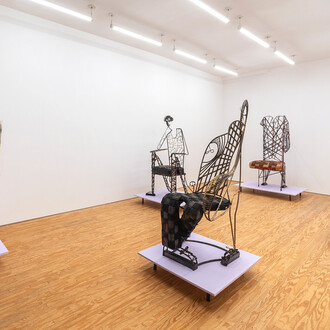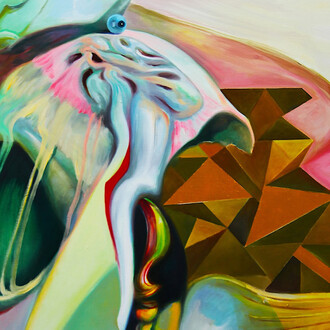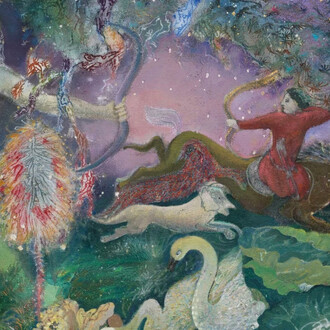March is pleased to announce 1995, a lesson in life drawing, a presentation of never before exhibited works from the final year of Charles Steffen’s life. A devoted draftsman and diary-keeper, the artist’s work is populated with figures from his memory, imagination, and daily life.
Prologue
In 1885, after months of preparation, Vincent Van Gogh completed The potato eaters, a portrait of the De Groot family, who he knew well and worked with often. The work served as an ambitious foray into figurative painting, and the challenging composition and darkness of the scene would serve as proof to many of the artist’s profound talent. To others, the work was a failure, laden with inconsistencies and unappealing to the eye. Today, The potato eaters is celebrated as a masterpiece and studied by artists around the globe. Such is life.
1995, A Lesson in Life Drawing
In 1995, Charles Steffen enrolled in a life drawing class at Truman College. His last formal art lessons had been over four decades prior at the Illinois Institute of Technology, where he first encountered abstract expressionism and the perils of bohemian society. Steffen’s return to formal education came at an unprecedented moment. His mother, a treasured presence, had died the year before, after which the artist moved to an apartment elsewhere in the city. Steffen was entering the final year of his life. He was also on the cusp of a creative breakthrough.
Steffen’s work was historically delicate, reminiscent of botanical illustrations, while his final drawings are weighted––they move and breathe, anchored in the immediacy of their production. These works evidence the artist’s stylistic refinement, balancing luxurious marks with frugal compositions. Where the majority of the artist’s work had been based on family and acquaintances, his life drawing class offered a chance to make portraits of strangers and focus on technical elements, a skill that would echo throughout all of his subjects.
Parallel to these formal sessions, Steffen continued to draw figures from art history, the past, and his day-to-day life. Rebecca, a certain bank teller, received particular focus, appearing dozens of times in the artist’s drawings. Steffen documents Rebecca in professional attire, sitting at her desk at the bank where they would have met; in other scenes, she’s imagined elsewhere, sometimes fully dressed, often drawn in the nude. Annotations regarding these artistic liberties take a shameful tone as Steffen admits to his vices (“it’s truly a wrong thing to do”), at war with an innate curiosity.
While the effects of his drawing class were undeniably potent, Steffen’s life drawings are inextricable from his drawings of life. The anonymity and formality of a classroom only enriched the most personal of Steffen’s subjects: his family, his beloved, and himself. From the portraits of Rebecca to iterations of The Potato Eaters, Steffen’s process consists of careful studies on each subject. He hones in on certain moments, exploring details while testing his abilities and imagination. Greater precision and analysis appear in these works, tempered by playful inquisitiveness. Self-portraits offer a grounding point, methodical and honest, while the red and white squares nod to Steffen’s roots in abstract expressionism and the experiences of his youth. The art historical studies tap into larger narratives of subverted history, and coupled with Rebecca, the bodies of work blend reality with imagined lives.
Chicago-born artist Charles Steffen likely saw his first paintings in the knave of his family’s Catholic church. As a young man, he would continue his art education at the Illinois Institute of Technology, where comparably irreverent Abstract Expressionism had taken a firm hold. It was at this time that he met Hugo Weber, an avant-garde artist and professor whose work and lessons would influence Steffen’s drawings throughout his life. He was influenced too by the writing of Lewis Carroll in Through the looking glass (1871), a story of exploration, alienation, and the world being turned upside down.
Following a decline in his mental health, Steffen departed early from art school in 1949, later continuing his research on the oeuvres of Van Gogh, Auguste Rodin, and Pablo Picasso during visits to the Art Institute of Chicago. For over four decades, Steffen made drawings constantly. He was dedicated to the quality of his work, occasionally critiquing or praising his efforts in the form of notes on the page. Intertwined with these reflections are accounts of the day’s events: what he ate, how he was feeling, his worries, anticipations, and desires. At times, he longed for the structure of formal education, writing about his desire for better materials and better results. He worked in the lineage of his inspirations; as Van Gogh did with The potato eaters, Steffen drew figures not only from memory, but from his daily life. His mother, siblings, and romantic interests appear consistently in his work, rendered in varying detail and often elaborated upon. The drawings themselves are sensitively stylized, while the artist’s annotations are comparatively raw.
Charles Steffen’s work has been exhibited at the Collection de l’Art Brut (Lausanne, Switzerland), the American Folk Art Museum (New York, NY), Reyes Finn (Detroit, MI), Russell Bowman Art Advisory (Chicago, IL), the Milwaukee Art Museum (Milwaukee, WI), Museum van de Geest (Amsterdam, Netherlands), 3331 Arts Chiyoda (Chiyoda City, Japan), Andrew Edlin Gallery (New York, NY), Dean Jensen Gallery (Milwaukee WI), Good Luck Gallery (Los Angeles, CA), and Galerie Christian Berst (Paris, France). His work is in the permanent collections of the Collection de l’Art Brut (Lausanne, Switzerland), Museum van de Geest (Amsterdam, Netherlands), the High Museum of Art (Atlanta, GA), Intuit (Chicago, IL), and the American Folk Art Museum (New York, NY). Steffen is included in Lucienne Peiry’s L’Art Brut (2016), Body: Art Brut/The Collection (2018), Revue de Belles-Lettres, 2022, 2 (2022), and Jean Dubuffet’s Art Brut: the Origins of the Collection (2016).
















